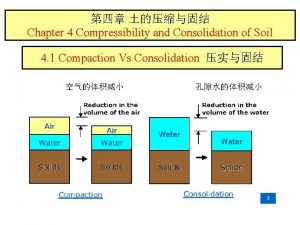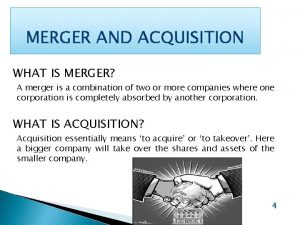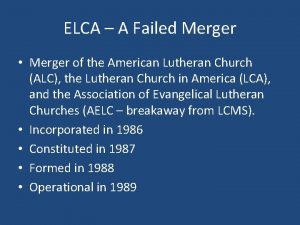LO 1 Merger versus Consolidation 23 1 Merger















- Slides: 15

LO 1 Merger versus Consolidation 23. 1 • Merger • One firm is acquired by another • Acquiring firm retains name and acquired firm ceases to exist • Advantage – legally simple • Disadvantage – must be approved by stockholders of both firms • Consolidation • Entirely new firm is created from combination of existing firms 23 -0

LO 1 Acquisitions • A firm can be acquired by purchasing voting shares of the firm’s stock • Tender offer – public offer to buy shares • Circular bid – takeover bid communicated to shareholders by direct mail • Stock exchange bid – takeover bid communicated to shareholders through a stock exchange 23 -1

LO 1 Stock Acquisition • No stockholder vote required • Can deal directly with stockholders, even if management is unfriendly • May be delayed if some target shareholders hold out for more money – complete absorption requires a merger 23 -2

LO 1 Acquisition Classifications • Horizontal – both firms are in the same industry • Vertical – firms are different stages of the production process • Conglomerate – firms are unrelated 23 -3

Takeovers LO 1 • Control of a firm transfers from one group to another • Possible forms • Acquisition • Merger or consolidation • Acquisition of stock • Acquisition of assets 23 -4

LO 1 Takeovers - continued • Proxy contest – Attempts to gain control of a firm by soliciting a sufficient number of shareholder votes to replace existing management • Going private – All publicly owned stock in a firm is replaced with complete equity ownership by a private group. • Leveraged Buyouts (LBOs) – Going-private transactions in which a large percentage of the money used to buy the stock is borrowed. Often, incumbent management is involved. 23 -5

LO 1 Alternatives to Merger • Strategic Alliance – Agreement between firms to cooperate in pursuit of a joint goal • Joint Venture – Typically an agreement between firms to create a separate, coowned entity established to pursue a joint goal 23 -6

LO 1 & LO 7 Synergy 23. 4 • The whole is worth more than the sum of the parts • Some mergers create synergies because the firm can either cut costs or use the combined assets more effectively • This is generally a good reason for a merger • Need to examine whether the synergies create enough benefit to justify the cost 23 -7

LO 1 & LO 7 Revenue Enhancement • Marketing gains • Advertising • Distribution network • Product mix • Strategic benefits • Market power 23 -8

LO 1 & LO 7 Cost Reductions • Economies of scale • Ability to produce larger quantities while reducing the average per unit cost • Most common in industries that have high fixed costs • Economies of vertical integration • Coordinate operations more effectively • Reduced search cost for suppliers or customers • Complimentary resources 23 -9

LO 1 & LO 7 Tax Gains • Take advantages of net operating losses • Carry-backs and carry-forwards • Merger may be prevented if the IRS believes the sole purpose is to avoid taxes • Unused debt capacity • Surplus funds • Pay dividends • Repurchase shares • Buy another firm • Asset write-ups 23 -10

LO 1 & LO 7 Reducing Capital Needs • A merger may reduce the required investment in working capital and fixed assets relative to the two firms operating separately • Firms may be able to manage existing assets more effectively under one umbrella • Some assets may be sold if they are redundant in the combined firm (this includes human capital as well) 23 -11

LO 1 & LO 4 Diversification 23. 5 • Diversification, in and of itself, is not a good reason for a merger • Stockholders can normally diversify their own portfolio cheaper than a firm can diversify by acquisition • Stockholder wealth may actually decrease after the merger because the reduction in risk in effect transfers wealth from the stockholders to the bondholders 23 -12

Defensive Tactics 23. 7 LO 1 • Corporate charter • Establishes conditions that allow for a takeover • Supermajority voting requirement • • • Targeted repurchase aka greenmail Standstill agreements Exclusionary offers and dual class stock Poison pills Shareholder rights plans 23 -13

LO 1 Defensive Tactics continued • Leveraged buyouts • Other defensive tactics • Golden parachutes • Crown jewels • White knight 23 -14
 What is mergers and acquisitions
What is mergers and acquisitions What is merger and consolidation
What is merger and consolidation Gpo and idn consolidation
Gpo and idn consolidation Recompression index
Recompression index Cycle 3 cycle de consolidation
Cycle 3 cycle de consolidation Consolidation
Consolidation Mao maintenance of power
Mao maintenance of power Coefficient of volume compressibility
Coefficient of volume compressibility Ad consolidation project plan
Ad consolidation project plan Information analysis and consolidation centres in 50 words
Information analysis and consolidation centres in 50 words Active directory consolidation best practices
Active directory consolidation best practices Chapter 25 the consolidation of latin america
Chapter 25 the consolidation of latin america Cycle de consolidation
Cycle de consolidation Us group consolidator inc
Us group consolidator inc Acca consolidation
Acca consolidation Cal vicieux tibia
Cal vicieux tibia




























